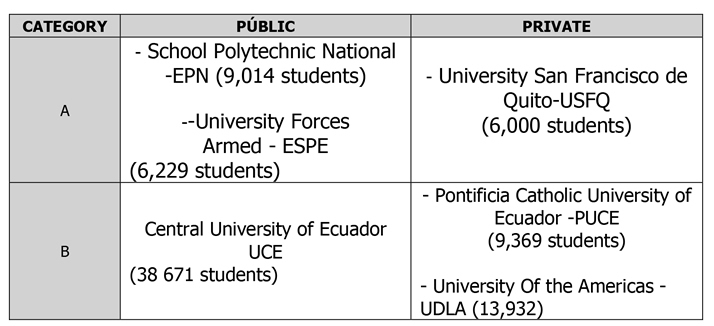
doi.org/10.15198/seeci.2016.40.27-47
RESEARCH
COMMUNICATING SCIENCE AND TECHNOLOGY IN UNIVERSITIES OF ECUADOR: PRELIMINARY STUDY OF IMPACT AND PERCEPTION IN THE UNIVERSITY POPULATION
COMUNICACIÓN DE LA CIENCIA Y LA TECNOLOGÍA EN LAS UNIVERSIDADES ECUATORIANAS: ESTUDIO PRELIMINAR DEL IMPACTO Y PERCEPCIÓN ENTRE LA POBLACIÓN UNIVERSITARIA
Sofía Cabrera1
Emma Camarero2
1University of the Americas. Ecuador
2Loyola University Andalusia. Spain.
ABSTRACT
This piece of research is a preliminary study and contextualization of the dissemination of science and technology through social networks in Ecuadorian universities and sets up the first results of the doctoral thesis of the lead author. Specifically, this study focuses on the institutions of Pichincha-Ecuador. In February 2016, an online survey was developed, with a sample of 50 students of each of the selected universities to define a state of the art to identify and assess college digital media the student population uses most for information. Once that survey was conducted, we proceeded to the analysis of the publications of Facebook, the most used social network by students in that period. The purpose is to identify models of disseminating science used by universities to select effective communication practices in digital media.
KEY WORDS: university, science, technology, dissemination, network.
RESUMEN
Esta investigación es un estudio preliminar y una contextualización de la divulgación de la ciencia y la tecnología a través de las redes sociales en las universidades ecuatorianas y configura los primeros resultados de la tesis doctoral de la principal autora. En concreto este estudio se centra en las instituciones de la provincia de Pichincha. En febrero de 2016 se desarrolló una encuesta en línea, con una muestra de 50 estudiantes por cada una de las universidades seleccionadas, para definir un estado de la cuestión que sirva de base para identificar y valorar los medios digitales universitarios más usados para informarse por parte de la población estudiantil. Una vez realizada esa encuesta, se procedió al análisis de las publicaciones de Facebook, la red social más utilizada por los estudiantes en dicho período. El objetivo es identificar los modelos de divulgación de la ciencia que utilizan las universidades para seleccionar prácticas de comunicación efectivas en medios digitales.
PALABRAS CLAVE: universidad, ciencia, tecnología, divulgación, redes sociales.
Recibido: 24/05/2016
Aceptado: 02/07/2016
Publicado: 15/07/2016
Correspondence: Sofía Cabrera
sofia_sice@usal.es
Emma Camarero
ecamarero@uloyola.es
1. INTRODUCTION
When the terms of communication and dissemination of science are used, it is necessary to contextualize them in the place referred to since, although the use of its words can change, the meaning of public and democratic transmission of knowledge is maintained. The terms most used in Latin America are: Social appropriation of science (Colombia), Chile and Argentina (social appropriation of scientific knowledge), Spain, Mexico and other Latin American countries (dissemination of science) (Lozano, 2003). All these terms entrench dissemination within a communication framework that seeks the expansion and updating of scientific knowledge with two conditions: that they are tasks done outside formal academic teaching without the aim of training specialists or perfecting them in their own area of knowledge (Erazo, 2007).
In the case of Ecuador, they work with the term “dissemination” under the influence generated throughout Latin America. In the country they are few and limited to the experiences of disseminating science that have developed over the last thirty years. The constant transformation of the State in the construction of public policies that support science as a fundamental pillar of social development was the main problem to generate products and spaces to popularize a solid scientific culture among the general public.
Lack of a science policy focused on studying and solving national problems and promoting civic awareness has led several countries in Latin America to a state of extreme dependence on the economic, industrial, political, scientific and technological aspects. Thus, science fails to fulfill its social role, because it does not contribute to the proper development of peoples. (Erazo, 2007: 118)
In the last thirty years, Ecuador has gone through several changes in the consolidation of a body to coordinate the actions of science and technology, passing from a foundation that depended on the Vice President and administered funds for research projects to a National Secretariat with the rank of a ministry in charge of policies for higher education, science, technology and innovation. (Salazar, 2015)
All this changes have redefined the treatment of science from a neoliberal system that considered it a chimera, ie a dream that does not materialize into practical action, set to private initiatives without state budget support to the development of a new model that prioritizes the transformation of the productive matrix based on a System of Social Knowledge Economy. However, in this constant change in planning and design of public policy, scientific dissemination has not been addressed with the relevance required to design specific lines of action in the socialization of scientific production in the country.
Although laws and decrees such as public S & T policies were included in the seventies, they were not enough to create a true Science and Technology System that compares to those developed in other Latin American countries at the same time. In the nineties, the conditions for science and technology in the country did not improve substantially either, due to lack of a specific budget for research and development (R & D). The activity of universities continues being weak, governmental research centers disjointed to each other and there is no development of an innovative industry (Salazar, 2015).
In the last decade, the government of Rafael Correa has been the promoter of change in the system of social knowledge economy. If we make a comparison with the years before the start point of the government (2007) with the process that has been generated until now, a number of attempts are observed to legislate science, technology and innovation, but with few operational tools of public policy, without a specific orientation to define the research lines for projects and long intervals of time between decision and implementation. That is, a too bureaucratic process and marked lack of interest by the different governments for the construction of an effective system of development of science, technology and innovation in Ecuador. (Salazar, 2015)
The drafting of a National Plan for Science, Technology, Innovation and Knowledge, a document that seeks to become a guide with strategies and guidelines protecting the actions of S & T in the country, began in June 2011. Although the construction of this Plan was carried out under a participatory model that sought the interaction of different actors of civil society: universities, research institutes, public and private companies, etc., by conducting workshops throughout the country, it had the same fate as the issues of plans before the government of Rafael Correa, it did not become an official document but allowed the development of policies that have now been grouped under a law that has been called “Code of Social Economy knowledge, Creativity and Innovation “- WITS CODE.
The Wits Code is defined as n official document that will regulate the system of Science and Technology in Ecuador. However, until the publication of this article, it is in the second debate for approval at the National Assembly so it has not even come into effect. In this law, for the first time a section related to public communication is included:
Article 117 Public communication.- public communication is defined as any act by which a plurality of people, whether gathered or not in one place, and when they decide individually, can have access to the work without prior distribution of copies to each of them. Especially included are the following acts:
1. Stage performances by any means or procedure.
2. Public presentation of audiovisual works
3. Issuance of works of media coverage (radio, newspaper, television) for wireless broadcasting
4. Transmission and retransmission of cable, fiber optics and another similar procedure
5. Public exhibition of works of art or reproductions;
6. Public dissemination, by any known or unknown process, of words, signs, sounds or images that exceeds the private sphere. (Section IV, Content of Copyright: COESC, 2015)
As previously reported, public communication and technology related to science and technology starts being legislated for the first time in a code that seeks to manage the System of Science and Technology in Ecuador. However, they are still considered general activities set forth in copyright and do not establish specific rules for all actors interacting in the system.
Due to all the above, the study presented in this article is part of a doctoral thesis aimed at analyzing management, impact and perception of strategies of public communication of science and technology in Ecuadorian universities, it aims primarily to consolidate a plan of good practices of university outreach and become a proposal that could feed Article 117 of the WIT Code policy; where the functions of public communication of science that college actors meet in the system are defined, a field that has not been completely determined yet. In addition, this piece of research acquires high relevance as an analytical contribution to universities in their optimization process of communication channels towards the dissemination of scientific culture.
Punctually, this preliminary study aims to analyze why it is important for universities to invest in effective communication processes enabling them to disseminate scientific production that generates and strengthens the construction of a scientific culture, and thus consolidate its social recognition. To contextualize the concept of scientific culture, it is interesting to use the definition of Leonardo Vaccarezza:
Scientific culture is meant to be understanding of the social dynamics of science, so that they all are woven, in an interrelation between producers of scientific knowledge and other social groups, as participants in the evolution of culture, producing meanings the origins and justifications of which come from different practices, interests, regulatory codes and power relations, this being understood as a continuous evolution. (Vaccarezza, 2008: 110)
As Vaccarezza explains, scientific culture is the understanding of the social dynamics of science and the interaction it weaves with different actors, not specialists, to build common meanings on the scientific issue. For this reason, it is interesting to analyze the case of Ecuadorian universities in building this culture from different communication strategies they use every day.
In this preliminary study, there is an analysis of what the main university digital media that students use to learn are; after these results, the social network Facebook is analyzed as students consider it the main source of university digital information. The study seeks to analyze the impact of publications of this social platform on science and technology and present data to enable those responsible for managing these social networks to optimize dissemination strategies based on content, language and public objectives.
2. OBJECTIVES
The objectives that motivate this preliminary research are related to describing student interaction with university digital media and publication dynamic of fan pages of facebook of universities as platforms for dissemination of scientific culture, to making a state of the art on management of communication channels in universities and to highlighting the positive actions on management and use that can be included in a model of popular science university plan:
a) Interaction of students with university social networks, their perception and acceptance as science disseminating media.
b) Management of the social network Facebook as an effective communication platform of university science dissemination.
The role of universities in scientific dissemination is critical because, in addition to teaching and research, transfer of knowledge to society in general is one of their missions, so constant updating of channels of public communication is required to fulfill this task. (Lascurain, M. and Sanz, Elias, 2009)
3. METHODOLOGY
As previously explained, this study is part of a doctoral thesis that has sampled six universities in the province of Pichincha in Ecuador. This preliminary section contains the analysis of two specifically studied objects: university students and the social network facebook. So as to know the perception of students about digital media of selected universities, an online survey was applied to a sample while publications of science and technology of official fan page of the universities of February 2016 were analyzed.
The study of Brito, JG Laaser, W. Toloza, EA (2012) on The use of social networks by universities at institutional level uses this methodology of intentional and comparative analysis of five Latin American universities to research the use / implementation of social networks by universities because of the importance of these new media in the management of institutional communication between and within various stakeholder groups. The authors call this model of study “communication analytics”, where they use surveys, interviews and analysis of official fan pages of institutions, discussing available figures and statistical methods to analyze the impact of data provided by social networks.
3.1. Selection Criteria sample size of universities in the region of Pichincha
As previously stated, in the last decade Ecuador has developed major changes in the areas of education, science and technology, with the aim of strengthening the production of knowledge, as a generator of a change of productive matrix and strengthen the System of Science and Technology based on the Social Knowledge Economy. This change is made from a political viewpoint, directed by the government of Rafael Correa, who took over presidency since January 15, 2007 to date and seeks to change educational processes to strengthen academic excellence measured with international quality standards.
One of the actions generated in this process is the creation of a Council of Evaluation, Accreditation and Quality Assurance in Higher Education (CEAACES), in charge of a process to categorize institutions of higher education in Ecuador, taking into account the analysis of parameters such as: academia, academic efficiency, research, organization and infrastructure. This classification is divided from A to E, the former being considered academic excellence and the latter academic deficiency, which forced the definitive closure of the institutions.
According to this categorization system, in this research we considered only universities in categories A-B, according to the latest report by CEAACES on May 10, 2016.
The six selected universities are detailed in the following table, according to the category in which they are now.
Table 1: Categorization universities

Source: Self made (2016) based on official data from each institution
As shown in the table above, the selected universities have a significant number of student population, which confirms their social position in the province; although they have obvious differences due to their public or private nature and their academic lines of action, they have characteristics such as the level of social acceptance that make them similar. The selected institutions are located in the province of Pichincha, four in Quito and two in the valleys surrounding the city.
3.2. Opinion survey to college students
The first tool developed in this preliminary phase is the conduction of an opinion survey to an intentional sample of students (50 for each selected university), by means of Survey Monkey software, to know their perception and acceptance of university digital media as platforms for dissemination of scientific culture.
This opinion survey, consisting of 7 questions, analyzed the use of digital communication channels of students, the frequency of interaction, the most visited social network, access to publications on science and technology from these networks, the language used and their knowledge about the concept of science.
3.3. Publications on Science and Technology in the Social Network Facebook
In the results of the opinion survey, an interesting fact was noticed, about 80% of surveyed students from all participating universities answered that Facebook is the social network they use most to learn about the events they perform at their university. It was considered important to analyze the publications in this social network.
The analysis was performed on the Facebook fan pages of selected universities in February 2016; there is a summary of the information published in the media, and S & T publications are classified for analysis.
As previously mentioned, the use of these two research tools will make it possible to analyze management and use of the social network Facebook by universities to reflect on the most effective practices allowing dissemination of scientific culture by these means.
4. DISCUSSION AND RESULTS
As we previously explained, the study is composed of two areas of research, on the one hand the survey of students and, on the other hand, the analysis of the publications of Facebook fan pages of the participating universities. Then the analysis of the results of these processes is presented.
4.1. Relationship between dynamic of students and Facebook posts
Table 3: Survey Question 1
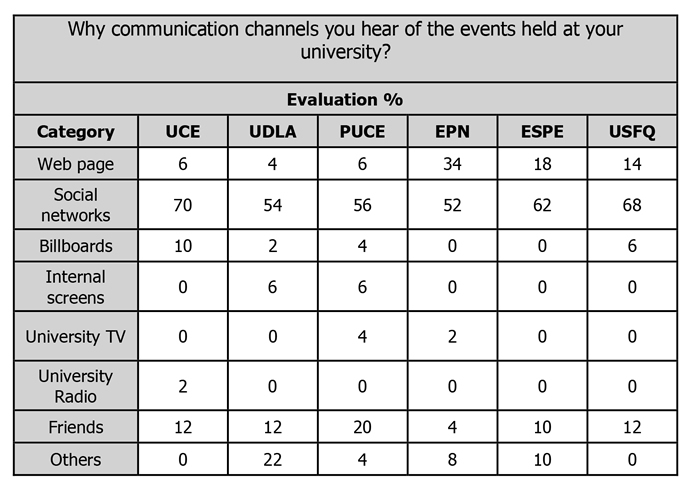
Evaluation %
With percentages ranging 52-70%, surveyed students say they mostly use university social networks to learn about news and events held at the university. The incursion of information and communication technologies has generated other forms of interaction in the new generations, so that this data confirms a pattern of consumption of digital media proper to this group of people.
An interesting fact in this answer is that, in the choice “other”, students from 4 out of the 6 participant universities (UDLA, PUCE, EPN and ESPE) say they also learn about the events of their university through the pages of “Memes”; These pages are created by students as an entertainment space on situations in college, but it shows that they are considered to be an important source of information. This figure would allow the communication directorates of universities to reflect on updated management of digital platforms with publications that arouse interest in students and, above all, to use their language for better reception and acceptance.
Finally, another important fact is the one related to the University of the Armed Forces (ESPE), which still maintains a military structure, some of the answers of students indicate that they are informed of the activities carried out through the civic minute on Mondays. In other universities like UDLA, a strong mailing service is maintained as another source of information, this is due to the fact that the university has mail platforms targeting students throuh which they constantly communicate with their teachers. In the EPN, users also expressed in a high percentage (32%) that they seek information via the website, which shows that there is considerable interest in the web publications of this institution, so the model used is working.
Table 4: Encuesta pregunta 2
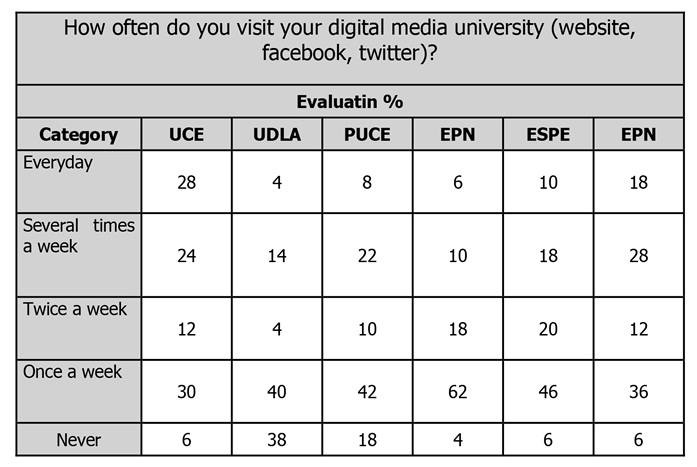
With a percentage of 30-62%, students say they visit college digital media once a week, which indicates a marked interest in being informed weekly of the activities conducted at the university. There are high percentages, such as UCE (28%), where students express they access digital media every day, in this case it would be important to know what type of information is reviewed by the students who have constant access to digital platforms. On the other hand, students from UDLA, with a high percentage of respondents (38%), say they never enter digital media of their college, this answer validates the above, the use of mailing at UDLAP strengthens direct communication with students, so they do not have a high interest in consuming digital media of their own institution.
It clearly shows that the social network most visited by college students is Facebook. This answer is validated according to research presented by digital Coverage (2015) which presents the strong growth of Facebook during the past six years. In Ecuador this social network grew from 400,000 users in 2009 to 8,000,000 users in 2015. Also the Institute of Statistics and Census (INEC) conducted a survey in 2014 to analyze the preferences for social networks in the country and data show that 41.4% of respondents have accounts on active social networking and Facebook is accepted by users.
This data is very important in this piece of research because, since facebook is the main source of information for students, it is understood that it is constantly updated by the communication officers of universities. In the case of Twitter, although reduced, a result (4.55% 2,04) is presented, which shows there is a percentage of students following these accounts. In regard to Instagram, there is a presented percentage (4-8%), a figure that shows the interest in following a social network that posts photos of everyday events at the university. Finally, in “Others”, there are students who, once again, mention MEMES pages that have been explained above.
Table 6: Encuesta pregunta 4
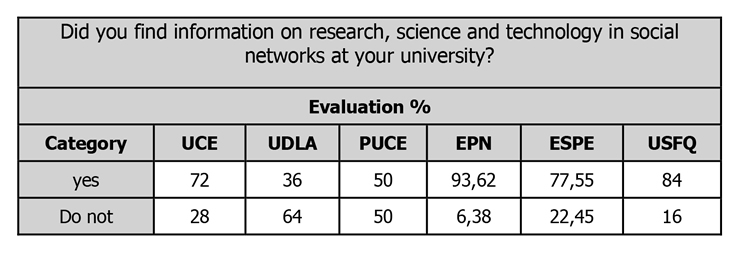
The answers to this question indicate that there are divided opinions about science and technology information published on social networks. The most striking data are those from UDLA (64i%) in which the vast majority of respondents indicate that there is no information on science and technology in university networks; Here one should analyze what kind of publications predominate in social networks so that there is this answer from students. In the case of PUCE (50%), the answer is interesting, because students indicate in similar percentages that they find and do not find this kind of information in social networks.
Table 7: Encuesta pregunta 5
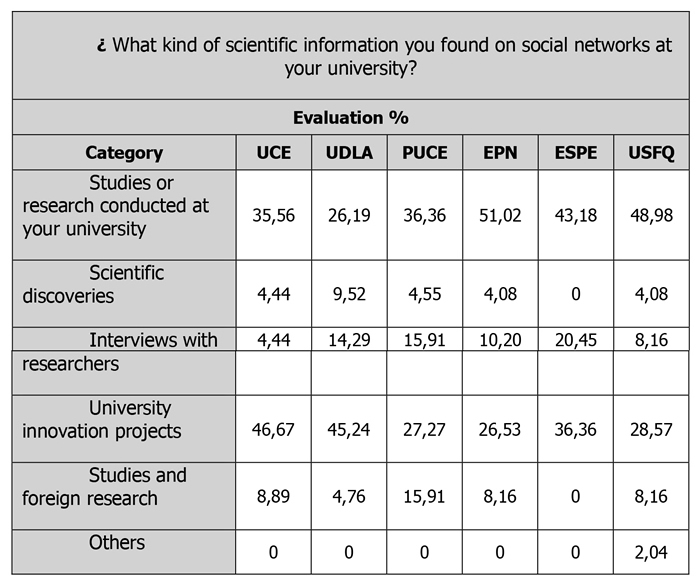
The data from these answers are also interesting. In UCE (46.67%) and UDLA (45,24), they indicate that the information that stands out in university digital networks is related to university innovation projects, this answer indicates that the novel results of projects conducted by students are constantly published. In PUCE (36.36%), ESPE (43.18%), EPN (51.02%) and USFQ (48.98%), the publication of studies or research conducted at universities stands out, demonstrating that there is dissemination not only of innovation projects as in the case of other institutions but also of other studies that are not only related to practical projects and are related to science in general. This data can show to some extent what kind of publications are to be found.
Table 8: Encuesta pregunta 6
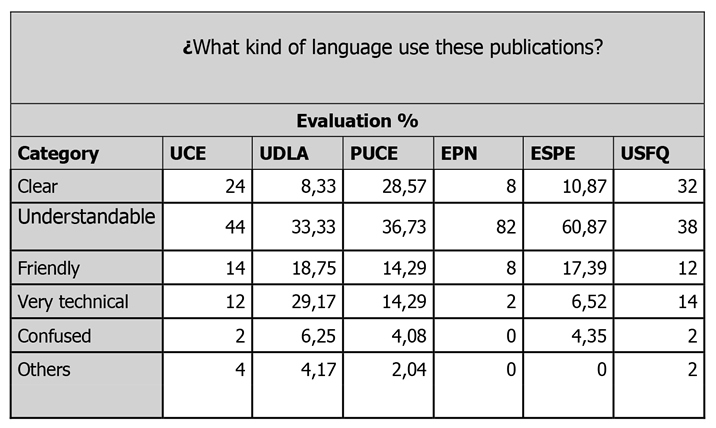
According to the data provided in this question, most respondents believe that the language used in the publications in university social networks is clear, understandable and friendly, demonstrating that visitors to these social networks clearly understand the scientific and technical concepts expressed in the publication, and also they try to handle terms easily understood by the target audience.
However, in four out of the six studied universities, there is a high percentage that states that the language used in publications is very technical; This is reflected in the data: UCE (12%), UDLA (29.17%), PUCE (14.29) and USFQ (14%). These data allow us to think that perhaps not all publications in facebook use a simple language easy to be understood by students.
Table 9: Encuesta pregunta 7
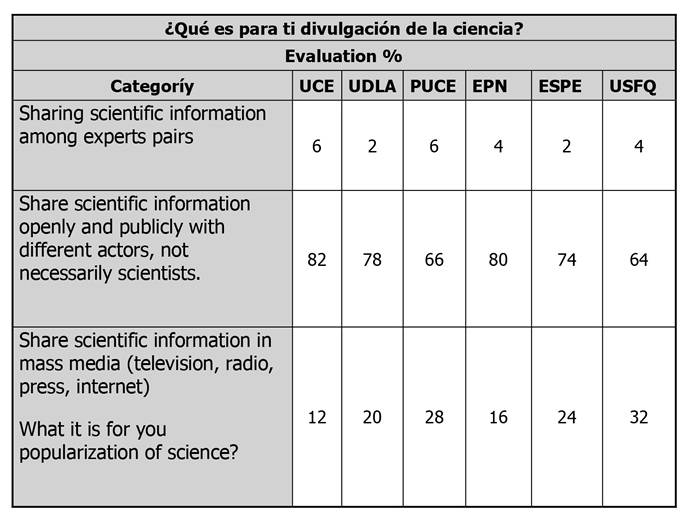
In this question, it is clearly shown that students clearly understand the meaning of dissemination of science, from 65% (USFQ) to 82% (UCE), on the concept of scientific dissemination "Sharing scientific information openly and publicly with different actors, not necessarily scientists."
However, a percentage, not as high, from 12% (UCE) to 32% (USFQ), also highlights understanding of the concept of scientific dissemination as: “Sharing scientific information in mass media (television, radio, press, internet) “, a concept that is linked to media communication, which relates to the answers of students because of their approach to science through television programs and journals specialized in the subject, but not to other publicly undertaken activities.
4.2. Facebook posts
After analyzing the results of the survey to students, then a contextualization of the publications generated in the Facebook fan pages of universities February 2016, with the number of publications generated on science and technology, is presented.
Table 10: Publicaciones de Facebook Universidades
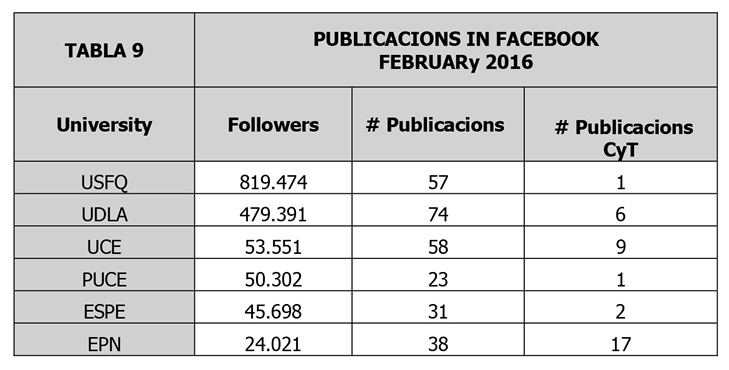
The table above includes the number of followers of each of the fan pages, the publications of the month and those related to science and technology.
USFQ is the university that has more followers (819,474), taking into consideration that the number of students of this institution is currently 6,000, this account has as followers internal and external public of the university. In February, it made 57 publications in its fan page and only 1 of these publications corresponds to science and technology. The publication refers to the invitation to a conference on “Ecology and Evolution of Communicable Diseases”, it does not generate more information about it and it can be considered only a publication of information.
What is perceived within the website is that this fan page has access to other microsites of the university and other facebook accounts of each of the schools (faculties) of the university where specific information is published, but it is not published on the official facebook page. It would be important for communication officers of this institution to strengthen science and technology publications in this space, when they have a large percentage of perceiving public to strengthen scientific culture.
UDLAP is the second university with the highest number of followers (479,391) on its official fan page. In February, they have 74 publications and 6 related to science and technology. In 2 out the of 6 publications they mentioned the articles of the researcher César Paz y Miño and the other 4 talk about research on the Zika virus that is currently in the national interest. As can be seen from these data, the institution conducts scientific dissemination of the pieces of research it generates, as well as promoting other communication products made by its researchers.
As regards UCE with a total of 53,551 followers, in February there are 58 publications and 9 are related to science and technology. These publications make reference to activities carried out by students such as specialization courses, open houses, conferences, dissemination of press releases on research that have been published in print media. The institution regularly publishes information about students, as they are the main perceiving public on this digital platform.
PUCE, with 50.302 followers, is the institution that has fewest publications in this network, 23 are in February and one on science and technology where students are invited to register for a specific event on “Research in Tropical Diseases”, no more movement is reflected in the social network and on the facebook page there are no microsites of access to other pages where you can get more information. It would be important for this institution to strengthen this cone communication strategies channel to meet the research activities of its students, teachers and the entire university community.
On the other hand, ESPE, with 45,698 followers, has 31 publications in February and only 2 on S & T. The publications make reference to a course on technology transfer and the other is on the signing of an agreement with the Governing Council of Galapagos and the Charles Darwin Foundation. Although the web page does not make constant scientific dissemination of the activities generated, ESPE has another fan page called “E-Science” where they perform dissemination strategies with their different audiences; however, this account is not completely recognized by all college students. It would be important to be able to better coordinate the publications that are unified in a single space providing greater access to the university community.
Finally, EPN is the last institution in this table, with 24,021 followers, it has 38 publications in February, but 17 are on S & T, according to data, it is the institution that most publications has in this field in relation to the others that were researched. Its publications are related to news on S & T by international agencies, invitations to events and interviews with researchers. Although it is the fan page that has fewest followers, it is the one with more information on S & T, varied information as mentioned above includes news and interesting facts about the topic. In this case, the interest of the institution to strengthen this communication channel as a space for dissemination with students is noticed.
Below is an interesting data about scientific publications made by the universities of Ecuador in 2014-2015. It is a ranking presented by SCImago Research Groupen where the Ecuadorian higher education institutions with the number of publications in SCOPUS, International Cooperation, Publishing High Quality and detailed Percentage of Excellence is detailed.
Table 2: Ranking y Producción científica de universidades en Ecuador.
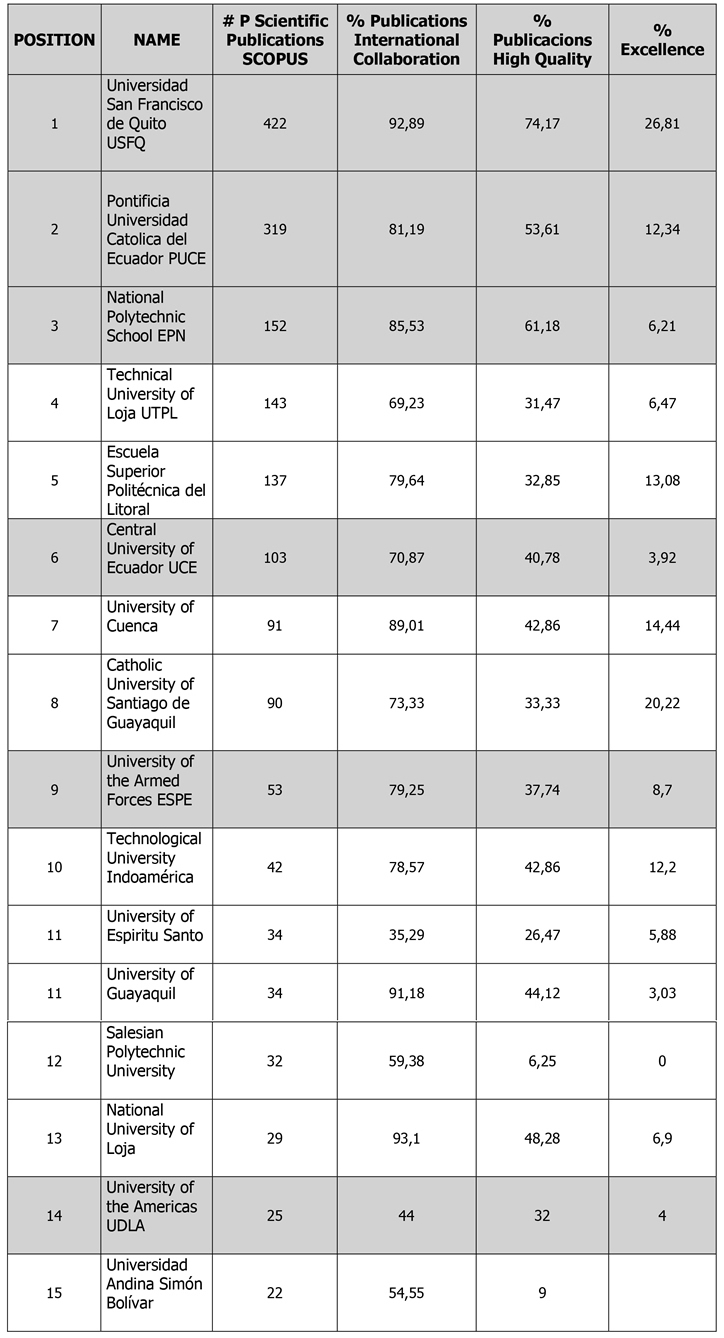
Fuente: SCImago Research Group, 2015
According to the presented information, the 6 universities in the sample are in the ranking of the 15 universities in Ecuador with higher scientific production. The institution leading the study is USFQ (422 publications) which, according to the analysis presented in this article, is one of the universities that carries out more scientific dissemination from different accounts of its schools (faculties); however, it is not potentiated on the official fan page of the university.
Second is PUCE (319 publications); however, it is clearly shown that they do not perform dissemination of the scientific production they generate, at least they do not do it in the digital media of the university, so it could be analyzed the other public communication strategies they use. It would be important for the university to use the social network of facebook and present short, simple publications on research carried out, but it still keeps a single model of specialized dissemination among experts.
Ranking in third place is EPN (152 publications) which, according to previous analyzes, is interested not only in scientific production but also in disseminating science. Although most publications of EPN are related to talks on S & T, analysis could later be made on whether the researchers who give talks are the same who generate the scientific production at the university. Here the university could expand disseminating strategies in its facebook, including more interviews and dynamic videos that explain the research done which would strengthen the interest of the public who follow them in this social network.
UCE appears in a 6th place in the table (103 publications) although, according to the analysis of this article, it is the second with more publications on science and technology in facebook, it could improve its dissemination, including communication strategies that include spokesmanships with the researchers of the university that contextualize the projects.
In 9th place is ESPE with (53 publications), a low figure according to the ranking but, as indicated in this analysis, they conduct disseminating activities that generate, not through the official fan page, but through other means.
Last is UDLA (25 publications), the institution that less scientific publication has according to the ranking but, according to this analysis, it is the one that promotes the researchers of its university and the communication processes they perform.
5. CONCLUSIONS
Once this analysis on student interaction with digital media of their universities and the dynamics of Facebook is made, it is concluded that the Ecuadorian universities in the sample perform little scientific dissemination in general and also in the official fan pages on Facebook on the scientific output they generate. The interest lies in publishing more information regarding general topics of the university such as invitation to courses, seminars, administrative information, sporting events, news about the activity of the rector and other authorities, etc.
On the other hand, regarding the issue of dissemination of S & T, there is no defined strategy on what to publish, how and where. Perhaps only the case of EPN stands out, which is the one with more publications in the month that was studied, and publications on interviews to its researchers and press releases on projects that are under way are categorized. A better coding of S & T activities to be posted on fan pages could optimize the science disseminating strategies of universities. This coding can be done by thinking about the diversity of events: open houses, seminars, forums, scientific cafes and other communication products such as interviews, media presence, micronotes and videos on research, etc.
Some universities have other fan pages to disseminate their activities, though it would be important to be able to potentiate the official fan page of the university so that it can be considered a primary source of information not only on the issues of university events but also on issues such as science and technology that enhance the development of scientific culture in the university community. A good example of this is what EPN does, which, in addition to publishing information about its researchers, it also posts news and interesting facts about science and technology, generating interest in its followers. However, in the case of this institution, they should think of a new strategy to expand its number of followers.
This conclusion is similar to that proposed by Brito, JG Laaser, W. Toloza, EA (2012) in their study The use of social networks by universities at the institutional level, which state that it is necessary for universities to maintain a single centralized institutional profile. As expected, this model is complex to implement it in medium or large universities, where it is virtually impossible to standardize and channel the information provided by institutes / decentralized authority. Also, the possible central control is contradictory to the philosophy of freedom that the networks embody; however, it is an action that improves the institutional profile of universities.
Dissemination requires a proactive attitude to arouse social interest in science. Researchers should be actively involved in planning and implementation of activities of university dissemination, because if its attitude is negative or rejecting, it collides with the low value it may have on this need and the advantage of the social recognition of its work. Dissemination should reach an important segment of the university and non-university population, not just disseminating it among those who are already interested but also gaining followers, as demand will be born from knowledge (Lascurain, M. and Sanz, Elias, 2009). It is important also to include novel strategies for students. The study already shows that a major source of information is the fan pages of “Memes” of universities, for their constant updating, dynamic and use of resources and languages that generate expectation and interest in young people. Social networks are informal continuous interaction platforms, so that their managers can use attractive resources, from colors to communication products to capture their recipients, ie by developing multimedia content management on these platforms.
In this regard, it is important for universities to consider the need to create specialized communication departments on scientific communication, or also to train staff specifically in science and technology disseminating efforts, where attitudes to disseminate are promoted. Dissemination of science cannot be considered an intuitive or voluntary activity for researchers, on the contrary, it should be included in systematic institutionalized planning requiring curriculum contents in which knowledge from scientific reality are unified with techniques and methodologies involved in communication as part of scientific training (Lascurain, M. and Sanz, Elias, 2009).
Finally, this first approach to the Ecuadorian universities shows that there are no defined strategies regarding scientific dissemination, that the few actions taken are at random and cyclical and they are carried out according to issues of national or university interest in science and technology. However there is not a specific strategy to disseminate information on science and technology to strengthen the construction of a scientific culture, especially in the case of facebook, taking into account its potential as the main source of information for students according to the presented data. If Ecuadorian universities included courses on dissemination for writing scientific papers both in undergraduate and graduate levels, it is also necessary to include training in dissemination of science, where both students and teachers can learn from this communicative mediation. Dissemination is based on mediation because, if communication between the specialist and the general public is complicated, a third actor (the mediator) is required to translate the language of the researcher to arouse interest, curiosity and emotion, Calvo (2000).Thus, this preliminary study allows us to define future research lines for the doctoral thesis, as is the case of a categorization of activities on S & T that the selected universities perform, addressing their dynamics and measuring their impact to put together a proposal for a plan with the good practices found in each institution on the most effective way to disseminate science in the Ecuadorian university.
6.- REFERENCES
1. Brito, J. G. Laaser, W. Toloza, E. A. (2012). El uso de redes sociales por parte de las universidades a nivel institucional. Un estudio comparativo. RED, Revista de Educación a Distancia, 32. Recuperado de http://www.um.es/ead/red/32.
2. Calvo Hernando, M. (2000). El Nuevo Periodismo de la Ciencia. Quito: Ediciones Ciespal.
3. Cobertura Digital (2015) Redes sociales Ecuador: Facebook pasó los 8 millones 2015. Recuperado de http://goo.gl/zGzkfJ
4. Erazo, M. A. (2007). Comunicación, Divulgación y Periodismo de la Ciencia, Una necesidad imprescindible para Ibero América. Quito: Editorial Planeta.
5. Fayard, Pierre. (2004).La Comunicación Pública de la Ciencia. México D.F.: UNAM- Dirección General de Divulgación de la Ciencia.
6. Lascurain, M. & Sanz, E. (2009). La divulgación científica en el entorno universitario. Coimbra: Universidad de Coimbra.
7. Lozano, M. (2003). La investigación como estrategia para la apropiación social de la ciencia y la tecnología”. Había una vez una iguana: Experiencias en apropiación social de la ciencia y la tecnología. Bogotá: Gobierno del Departamento de Guajira.
8. Salazar, A. (2015). La construcción de las políticas públicas de ciencia, tecnología e innovación en la República del Ecuador (Período 2007-2015). Tesis inédita de maestría. Universidad de Buenos Aires, Buenos Aires.
9. Scimago Research Group (2015). Ranking y producción científica de universidades en Ecuador. Recuperado de http://www.scimagoir.com.
10. Vaccarezza, L. S. (2008). Exploraciones en torno al concepto de cultura científica. En Congreso Iberoamericano de Ciudadanía y Políticas Públicas de Ciencia y Tecnología. Madrid.